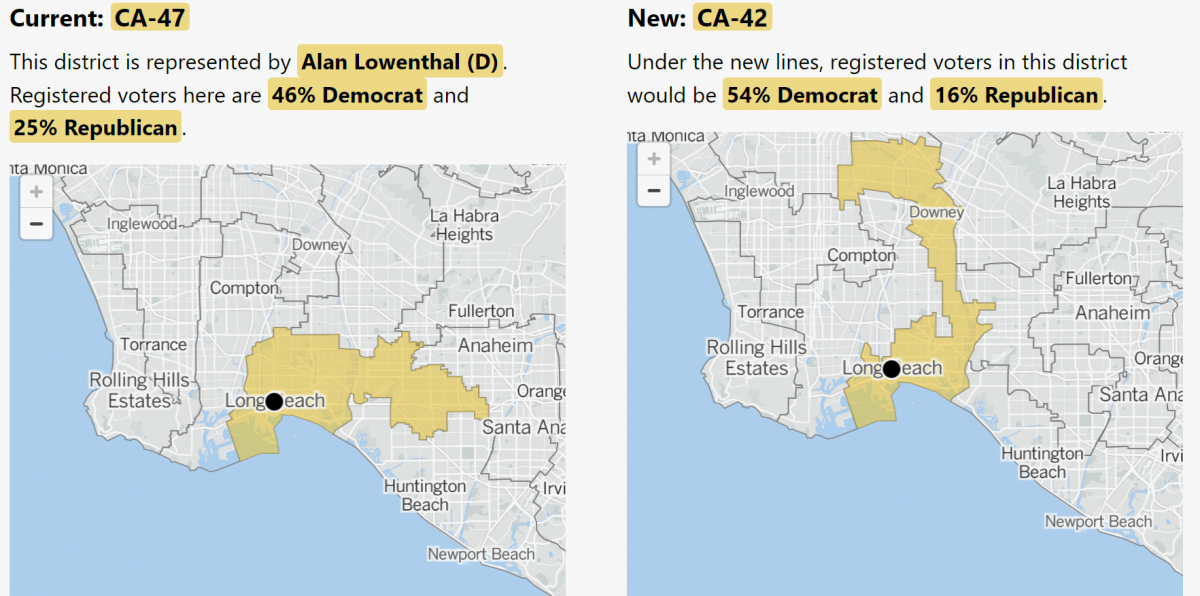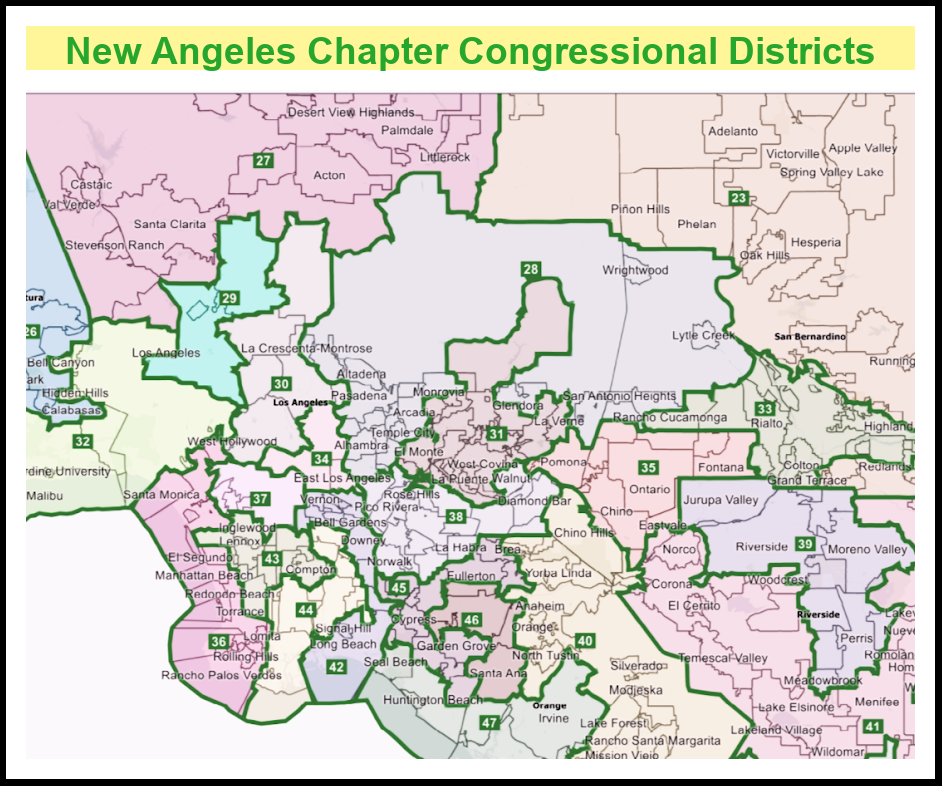
Angeles Chapter ExCom member John Monsen recently interviewed Sam Sukaton (pictured below) about the redistricting of congressional and legislative seats in California and, more specifically, in the Angeles Chapter. Sam is on the Sierra Club National Political Team. As part of his day job Sam managed a statewide redistricting campaign for the California Environment Voters. John managed a redistricting campaign for Nature for All that resulted in all of the public land in the Angeles and Western San Bernardino National Forests being located in more environmentally friendly congressional districts.
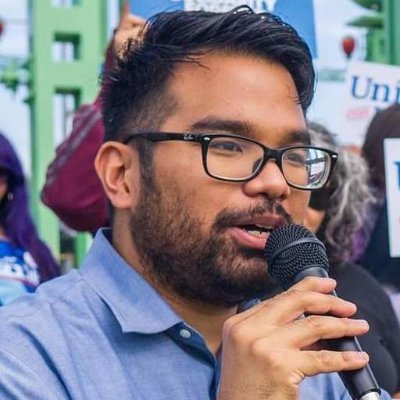
John: This year Sierra Club members will help elect public officials from new congressional and state legislative districts recently established by the California Citizens Redistricting Commission. Can you tell us what redistricting is and why it is so important?
Sam: Every 10 years after the census, when everyone in the United States is counted, all political jurisdictions in the United States from the state legislature, the House of Representatives, all the way down to cities, school boards and water districts draw new electoral districts that candidates run in. This process is called redistricting.
Beginning with the June California primary, people will be electing members of Congress from new Congressional districts that may be shaped very differently from the one they currently live in. Some areas changed more drastically than others. The most change took place in dense communities like Los Angeles.
I encourage folks to
explore these new maps of congressional and state legislative districts and think about the issues that animate them. We need to reintroduce ourselves not only to our electeds but to other people in our new districts. Look up who your new neighbors are. There is the possibility of new coalitions.
Read up on the demographics (especially Appendix 3). Know what congressional and state legislative districts you are going to be in and what they are like.
A good tool for comparing your old and new congressional district is supplied by the LA Times.
John: Does having an independent redistricting commission reduce or eliminate gerrymandering?
One challenge of redistricting has always been gerrymandering, where members of the state legislatures draw districts to benefit themselves or their party. California eliminated gerrymandering in 2010 by creating the independent
California Citizens Redistricting Commission with 14 members that generally does a far fairer job than the state legislature.
John: Will we see a more pro-environment state legislature as a result of redistricting?
There's a good possibility of a full environmental majority within the Democratic supermajority in both the Assembly and the State Senate. We're seeing strong environmental candidates emerge all over the state. So we're expecting probably a legislative supermajority of somewhere in the high 50s or breaking 60 out of 80 seats in the Assembly. Very similarly in the Senate high 20s, maybe breaking 30 out of 40. The Santa Clarita and Antelope Valleys are getting new seats that are possible Dem swings. There's a new high desert seat East from Lancaster to Victorville. We're seeing a great many resignations on both sides. Partially because governing during COVID is hard, partially because a lot of folks are looking at their jobs and saying I'm not doing this. We’re going to see more Democrats in the Central Valley. We will have to see if these are environmental Democrats.
John: The Los Angeles Times' reported that most of the state’s 42 Democratic congressional incumbents largely fared well in redistricting while nearly half the state's 11 Republican members of Congress will see their districts grow more blue. Does that sound about right?
Sam: It is on the right track but it is more complex than that with some districts changing dramatically, new districts with no incumbent, retiring incumbents and incumbents switching districts. Examples of that last point are central Orange County Democrat Katie Porter who plans to run in the predominantly coastal 47th congressional district and central California Republican Tom McClintock who will be running in the new 5th congressional district south of his current one. In the interest of being cautious and because this is a non-presidential election year, I think the Democrats pick up one or two congressional seats this fall in California. An example might be the new Congressional District 3 that includes the Eastern Sierra. Or Republican David Valadao’s heavily Democratic 21st district in the San Joaquin Valley.

New 27th district, left, has a slightly higher percentage of registered Democrats than before, which could spell trouble for Republican Incumbent Mike Garcia who won his last election by 333 votes. Rep. Judy Chu’s new 28th district now includes the San Gabriel Mountains in the Western San Bernardino National Forest. Redistricting in 2021 located all of this important national forest land into more friendly congressional districts, which has long been a goal of Sierra Club Angeles Chapter forest activists.
John: The new 27th that includes Santa Clarita, and the western section of the Angeles National Forest, Palmdale and Lancaster also comes to mind as a possible loss for the Republicans.
Sam. Absolutely. The 27th is entirely within the Angeles Chapter. The more conservative Simi Valley was removed from the district. Housing costs are pushing folks to Lancaster and Palmdale which means that pro-environmental voters are moving in from more liberal areas. Folks who worked on public lands issues like yourself and other Angeles Chapter members who engaged very heavily with former Santa Clarita Rep. Republican Buck McKeon served as a foundation on which to build. And people are dealing with the legacy of our aerospace industry and some of the toxic remnants we left behind. The 27th has been moving slowly left for a long time and the removal of Simi Valley from it means that Republican Congressman Mike Garcia could be in trouble in 2022. The district now has a 42% White, 34% Latino, 10% Black and 9% Asian voting age population.
John: So the 27th leaned a little bit Democratic before but it now leans a few more points Democratic. Is that the way to put it?
Sam: Yes. Democrat Christy Smith lost by 333 votes in a presidential year. Now the Democrats have a 14 percentage point edge over Republicans. Biden and Newsom both took the district. Even with off year vote slippage, the district is certainly in play.
John: We went from 53 congressional seats to 52 after the 2020 census. What seat was lost?
Lucille Roybal-Allard’s district in east and southeast Los Angeles was eliminated. Her district was amalgamated with Alan Lowenthal’s district, another longtime environmental champion from Long Beach. Both of them opted to retire. March 11 is the filing deadline for June 5 primary. We are expecting Assemblymember Christina Garcia, Long Beach Mayor Robert Garcia and Pastor William Moses Summerville to be among the candidates in the new 42nd congressional district that runs north from Long Beach north to Huntington Park. As you would expect from the registration numbers, all are Democrats.
John: You ran a comprehensive campaign to influence the shape of our 52 congressional seats, 40 State Senate Seats, and 80 Assembly seats all in coordination with civil rights, environmental and community groups. It was a pleasure to get a chance to work with you. Can you tell us about the campaign and its objectives?
California Environmental Voters (LEV) is the new name for the California League of Conservation Voters, the state affiliate of the National League of Conservation Voters. We decided to get involved in 2021 since it's a decade of climate action. We know we need bold leadership that can lead in a more assertive way. So making sure that the environment itself and the communities of interest that it articulates are part of the redistricting conversation was key to our mission. 2021 was the second time the environmental community has engaged with the nonpartisan redistricting commission. You were among the people who helped get efforts like these going in 2011.
For us at California Environmental Voters redistricting is about concentrating the power of historically disenfranchised communities and recognizing that the environment itself, California's natural environment, creates communities of interest. The 2022 elections are particularly important for us as citizens and for the broader conservation and environmental justice communities. We need to act now, not later, on the climate crisis.
We developed what we call the Green Map Grassroots Racial Equity and Environmental New Majority Advocacy Project. We worked with community organizations across the state in every district and specifically here on Angeles Chapter turf. For example, we worked with Nature for All, whose campaign you managed, Active San Gabriel Valley, Black Women for Wellness based out in Leimert Park, and many more. We not only wanted the commission to be compliant with the Voting Rights Act but we wanted to make sure that we were empowering communities of color to send leaders to Sacramento and Washington, especially because we know that polling has shown Black, Latino and Asian American voters want to support climate action, public lands and green space.
Sam: One of the goals of the California Environmental Voters Education Fund redistricting campaign was to elect more pro-environmental public officials, not just more Democrats. Can you tell us more about this?
The path to a pro-environmental majority in the House of Representatives runs through California. The way many of the seats were redrawn, they will be more competitive for environmentally identifying candidates. There's one new seat pickup for us, the California 3rd Congressional District that includes the Eastern Sierra - which, while it leans R on registration, is also host to 10 million acres of publicly-owned land and dozens of communities dependent on those acres for federal investment, state investment, and tourism dollars. The path to federal climate action still runs through the California congressional delegation, and there are just enough changes to make things very interesting, particularly here in Southern California.
Some elected officials are retiring because they feel that their new districts aren’t favorable to them or because they are running for other seats. We are going to have about 30 open seats in the state legislature, which gives us the opportunity to elect not just a larger Democratic majority but majorities in the Assembly and State Senate that are solidly pro-environment. We hope we will be electing a whole bunch of new folks that are going to be taking California forward on climate action and protecting public lands. As a result of redistricting there absolutely is a path to an environmental majority in both houses of the legislature.
John: I was pleased to see that 16 of the 52 new California Congressional districts now feature Latino majorities, up from ten. There are eight more total Latino majority seats in the Assembly and the Senate. What is your take on the growing electoral power of people of color? This has occurred in part by the involvement of civil rights, community and allied groups.
The results are gratifying. Across the state one of the great stories about redistricting is the upswing in Latino majority districts, particularly in the Central Valley. It has been a long time coming. The demographers have been talking for decades about the rising of a new American majority. We also have a history where Latino voters don't just exist but are mobilized going back to Cesar Chavez in the ‘70s. And, of course, we have a history of strong African American and Asian leadership from former Assembly Speaker Willie Brown to Senator Alfred Song and Congresswoman Judy Chu, to name only a few. Although the expansion of the Latino vote is not particularly new it is like a stone rolling down hill and gaining momentum.
John: Part of the value of your campaign was making both the natural world and the environmental challenges faced by under-resourced communities themes of the redistricting discussion.
Sam: We understand the world around us through natural features, through our land, through our air, through our water. It is important to make the environment itself a community of interest that articulates part of the conversation. We did that during the 2011 redistricting. Sierra Club veterans are familiar with the creation of the current 27th Congressional District represented by Judy Chu that includes Pasadena and the San Gabriel Mountains National Monument. This district was shaped by natural features at our request. You helped make this happen. There was a congressional district created in 2011 that ran the entire north coast from Marin to the Oregon border. Think about it. Doesn’t the Salton Sea create a community of interest? How do nature features overlap with African-American, Latino and Asian-American populations? Redistricting should recognize the very loud and very consistent California call for climate action. We did that well this round in districts like the new 42nd which include Long Beach and polluting transportation corridors running north.
John: Two drivers of Commission decisions were the Voting Rights Act of 1965 and grouping communities of interest together in the same congressional districts as much as possible to increase their influence. Can you tell us more about COI’s?
Sam: Communities of interest are groups of people who share common social, economic or environmental concerns who should be placed together in the same congressional or legislative district for effective representation. Examples would include the foothill cities south of the San Gabriel Mountains, coastal cities, low income communities, and the residents of the new 42nd district who share the common issue of air pollution and health problems it causes.
John: Can you explain how the Voting Rights act works? My oversimplification would be that redistricting agencies must create majority minority districts whenever possible to increase the ability of a racial minority, as the act puts it, to elect candidates of their choice.
Sam: That is an excellent one sentence summary.. The majority needs to be based on the “citizens of voting age population” or CVAP. One challenge we have noticed over the years is that there are places where historically disenfranchised populations have not been able to elect the candidate of their choice when a district was, say, only 50% Latino. It became our goal this year to increase CVAP from 50% to 55% or 60%. So you will see a lot of seats now where Latinos have a larger majority. In places like Los Angeles County, you'll see that at times in conjunction with very high African American CVAP. At a higher percentage the Latino community has a much stronger ability to elect the candidate of their choice, who may or may not be Latino.
John: 17 of the 52 California congressional seats are in the Angeles Chapter. Let’s talk about some of them. How do you think congress member Katie Porter will do this fall? She will be running in the new 47th CD, which includes generally conservative Beach cities from Seal Beach to Laguna Beach that are new to her along with the more liberal Irvine she represents right now.
Sam: We made the case that coastal communities were a community of interest as we did in 2011. In commission terms communities of interest should be in the same Congressional district. So, you know, seeing the 47th focused on the coast was something really, really gratifying although we did push for a more Long Beach/Huntington Beach arrangement. We feel very good about this district electing an environmental champion to Congress. Voter registration among the parties is tight but past performance makes me feel a little more comfortable. Biden would have won the district 52-48 percent and Newsom 55-44. Again, I’m not going to let God make a liar out of me, but the numbers look good for us and Congressmember Porter as ever works very, very hard not just on the government side, but on the campaign side. But it could be close.
John: Can you give us an example of a district you advocated that was organized around an environmental justice issue? The ports of LA and Long Beach come to mind.
Sam: Absolutely. The ports are tied to the 710 and 110 freeways. Trucking corridors bring pollution to historically disenfranchised communities. We advocated that folks closest to a problem should be able to elect those who deal with the solution. The Commission accepted our principles but in their wisdom reasoned that since the ports of LA and Long Beach are governed separately, it might make sense to have the two ports in two separate congressional districts.. And so were the 42nd and 44th CDs. The new 42nd congressional district includes Long Beach, Signal Hill, Catalina and cities probably as far north as Huntington Park. The new 44th is more familiar territory for Congressmember Nanette Barragan who's new CD runs from San Pedro north to Lynwood and South Gate. In the end you now have two members of Congress oriented towards the ports and oriented towards the pollution that the ports generate.
John: What are some other congressional races we should watch?
Sam: How Republican Young Kim does in the new Inland Orange County 40th District. Biden would have won here, but barely. Another close race will be in northern OC’s 45th district where one-term Republican Michele Steel will be running. Similar call to the 40th. Tossup. That this is an off-year election works in favor of the two Republicans.
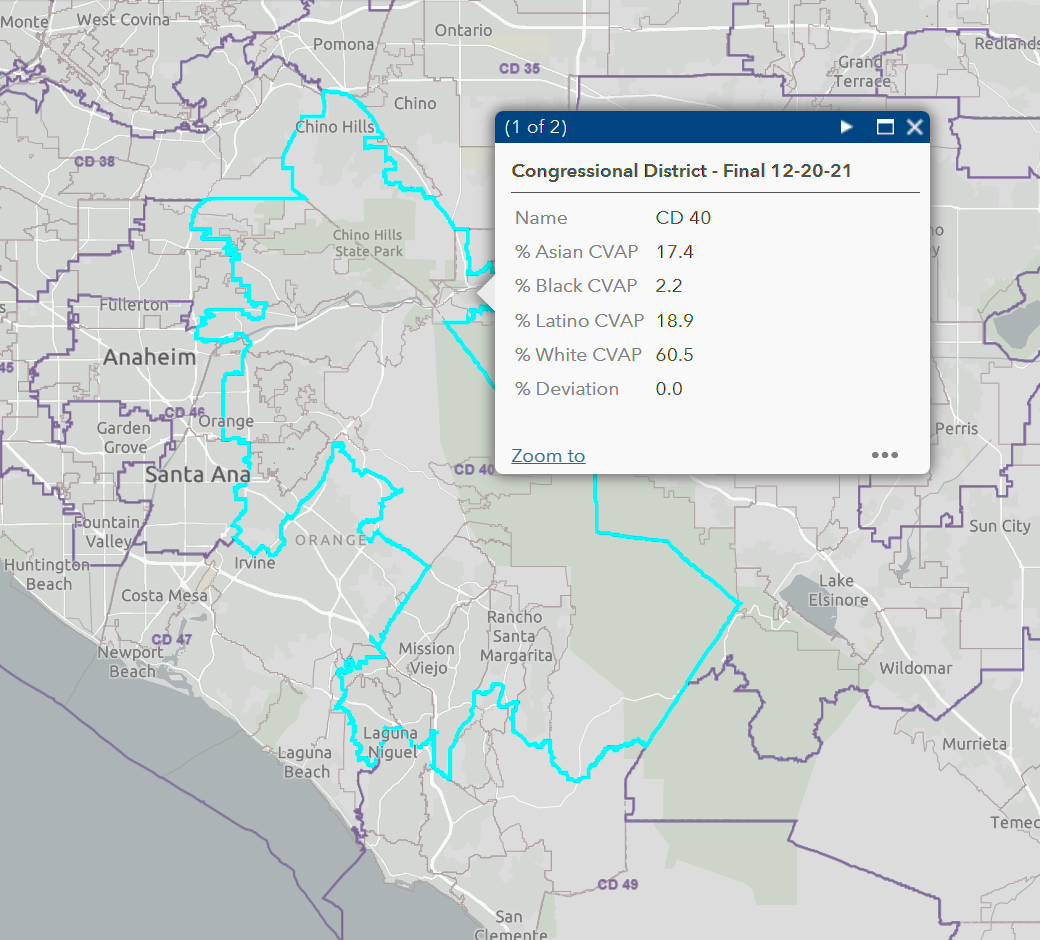
First term Republican Young Kim is running for reelection in the new 40th district. She may have an edge with voter registration favoring the Republicans and 17% of the citizens of voting age (CVAP) being Asian.
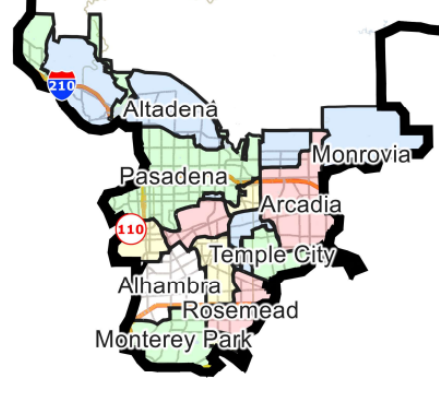
Inexplicably, last November the redistricting commission proposed dropping highly AAPI-populated Alhambra, Rosemead and Monterey Park from Rep. Judy Chu’s new 28th District. A coalition led by AAPI groups and supported by environmental groups got the decision reversed.
John: We had a close call in the new 28th district where public lands and environmental justice champion Judy Chu almost had half of the robust west San Gabriel Valley Asian American Pacific Islander community put in another congressional district, diluting Asian voices. This was a horrible idea that we fought against. What happened?
Early last November when the first set of draft Congressional District maps were issued by the Commission the Asian American community was split, putting Alhambra, Monterrey Park and Rosemead in an adjacent heavily Latino District. It was not a great moment for the Voting Rights Act. The Asian American community and the environmental community immediately recognized that keeping Asian American community concentrated was critical to their being able to elect candidates of their choice. AAPI groups, Nature For All, Active SGV, and many others, including the LEV campaign helped get these communities back into the 28th district where they belonged. Forest Service statistics indicate that a growing number of Asians are using the Angeles National Forest. Rep Chu’s district has a major section of forest, which gives the API Community a voice in how their federal public land is managed. District 28 was also extended east to include the San Gabriel Mountains located in the San Bernardino National Forest, putting most of the San Gabriels in one congressional district, which can allow us to have all of the San Gabriel Mountains addressed in future public land legislation.
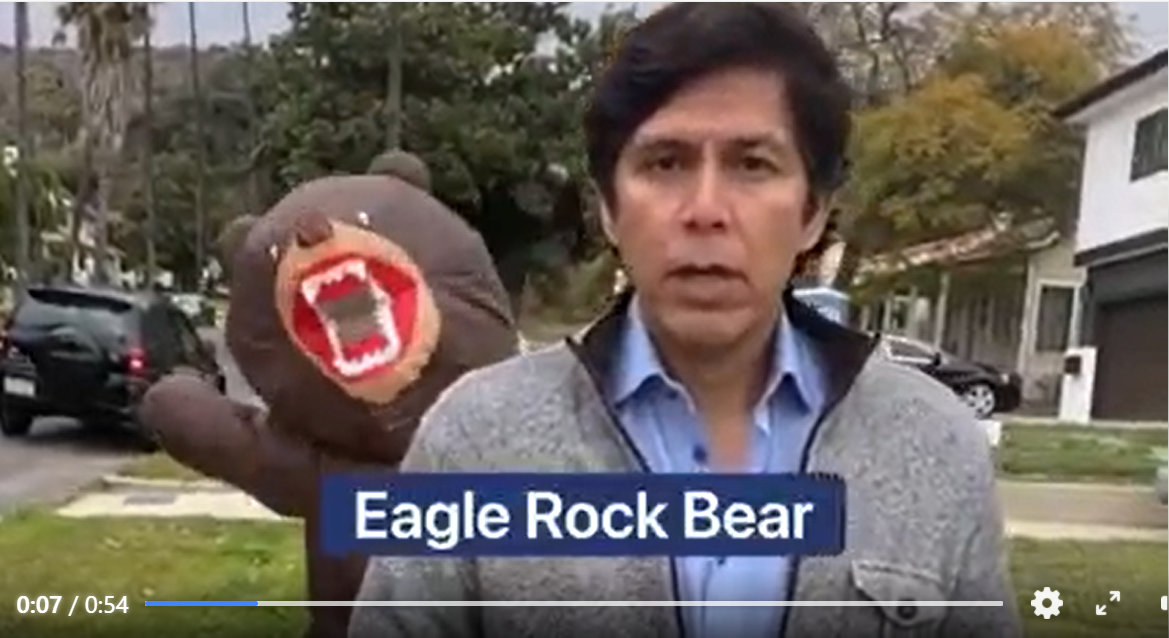
Sometimes it is good to paws, reflect and get your bearings. Ursine puns koala-fide as humor during LEV’s redistricting campaign after commissioner Sadhwani posted this Kevin de Leon video to more than scat-tered a-paws. It led to some serious discussions about the environment and redistricting. Word has it that de Leon was unfairly accused of panda-ing to his Eagle Rock constituents.
John: Do you have any stories about interaction with commissioners that might be interesting to our readers?
Sam: Let's talk about bears. Early on Commissioner Sadhwani who lives in La Canada posted
a video by a LA City councilmember Kevin de Leon about a bear wandering around Eagle Rock. There was a dancing "bear" in the background that was very funny. She asked if bears were a community of interest. And I tweeted back, you know, Commissioner, there is absolutely a bear COI and it would look something like the Angeles National Forest. Eagle Rock is a bear corridor. There is a community of interest of folks where bears interact with urban life. So she laughed and you know, it started a positive relationship. And so every time I spoke to the commission, at any moment, I'd make an ursine pun. And it drove some of them bonkers. During especially stressful moments I would call in and crack a bear joke. You know, I could see the reaction. Towards the end our conversations got a little more pointed. We submitted a long letter to the commission with criticisms of their first draft maps. I think the bear theme kept the mood lighter and it really made the environment stand out as a specific voice in deliberations.



